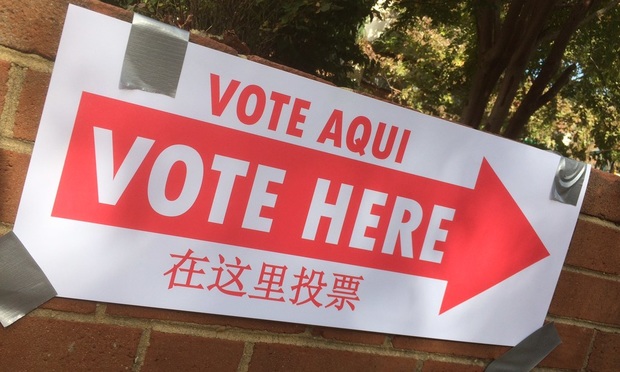Justices Struggle to Divine a Line for Partisan Redistricting's Round 2
The U.S. Supreme Court appeared no closer Wednesday than it was in the first case in October to divining a test for when too much politics infects redistricting.
March 28, 2018 at 02:56 PM
5 minute read

The U.S. Supreme Court, emerging from Wednesday arguments in its second partisan gerrymander case this term, appeared no closer than it was in the first case in October to divining a test for when too much politics infects redistricting.
In Benisek v. Lamone, Mayer Brown partner Michael Kimberly argued that Maryland Democratic lawmakers created an unconstitutional partisan gerrymander when they flipped a safe Republican district to a Democratic district. The lawmakers intentionally singled out voters in the Sixth congressional district and retaliated against them because of their voting views, he said, and that violated the First Amendment.
Maryland Solicitor General Steven Sullivan argued, in contrast, that the Sixth District was a “competitive” district, not a partisan gerrymander. Kimberly's First Amendment theory, he added, was not a good fit in the redistricting context because of its reliance on legislative intent.
The Maryland challenge differs from the first case heard by the justices—Gill v. Whitford from Wisconsin—in basically three ways:
➤➤ The Maryland case challenges a single congressional district; the Wisconsin case involves the entire state legislative map.
➤➤ The Maryland challengers urge the justices to adopt the First Amendment as the manageable standard for judging partisan gerrymanders; Wisconsin challengers rely on the equal protection clause and the First Amendment.
➤➤ The Maryland case comes to the court in an early stage—after a three-judge district court denied the challengers' motion for a preliminary injunction. The Wisconsin challengers won after a full trial before a three-judge district court.
The justices have a third partisan gerrymander challenge in the wings—from North Carolina. But they are holding that case pending decisions in the other two.
Here are some quick takeaways from Wednesday's arguments:
Calendar watch: Is it too late to do anything before November? Several justices indicated that if the court reversed the denial of the injunction, it would be too late for the lower court to fix the alleged gerrymander before the midterm elections in November.
“An order by this court indicating, oh, there might be time is going to upset settled expectations,” Justice Anthony Kennedy said to Kimberly. “Are you suggesting that it would not be disruptive of the current election scheme in the current election districting for this court to remand to consider whether the map should be changed at this late date?”
Kimberly said that such an order would only “perpetuate the same sort of uncertainty” that has been hanging over Maryland politics since the lawsuit was filed in 2013. Whether there is time to adopt a new map, he added, is an issue for the district court if the case goes back.
Chief Justice John Roberts Jr. noted one of the factors in winning a preliminary injunction is the threat of irreparable injury. He told Kimberly that elections in the challenged district had been held in 2012, 2014 and 2016. “That you've been willing to let go the elections [in those years] suggests that maybe in 2018, you're not going to be irreparably harmed in a broader sense,” Roberts said.
Some doubting over the First Amendment test. Kimberly and Sullivan faced tough questions and hypotheticals from a number of the justices on whether the First Amendment was the best test for these types of challenges.
Justice Samuel Alito Jr. told Kimberly that under his legal theory, “If I understand it, I really don't see how any legislature will ever be able to redistrict.” Other than a de minimis partisan advantage, Alito said, Kimberly's theory always would find a constitutional violation.
“But hasn't this court said time and again you can't take all consideration of partisan advantage out of districting?” Alito added.
During Sullivan's time, Kennedy asked if the Maryland constitution had a provision that required partisan advantage for one party as the predominant consideration in districting, would it be lawful?
Sullivan replied, no because it would be viewpoint discrimination. Kennedy asked, “How is this case different?”
“Damning evidence.” Justice Sonia Sotomayor told Sullivan, the Maryland solicitor, that there was “some pretty damning evidence” that there might not have been, as he claimed, reasons other than pure partisanship for flipping the Sixth District from Republican to Democrat. She cited then-Democratic Gov. Martin O'Malley's testimony that he felt duty-bound to ensure his party won. Based on that and other evidence, Justice Elena Kagan said to Sullivan, “However much you think is too much, this case is too much.”
Put all the theories on a single blackboard, Breyer says. Perhaps sensing that his colleagues in this case and the Wisconsin case are failing to coalesce around a gerrymander standard, Justice Stephen Breyer proposed taking all three cases and setting them for re-argument on the question of a standard.
“There we'd have right in front of us the possibilities as thought through by lawyers and others who have an interest in this subject,” Breyer suggested to Kimberly and Sullivan.
“You could have a blackboard and have everyone's theory on it, and then you'd have the pros and cons and then you'd be able to look at them all and then you'd be able see perhaps different ones for different variations,” he added.
None of his colleagues picked up on his proposal.
This content has been archived. It is available through our partners, LexisNexis® and Bloomberg Law.
To view this content, please continue to their sites.
Not a Lexis Subscriber?
Subscribe Now
Not a Bloomberg Law Subscriber?
Subscribe Now
NOT FOR REPRINT
© 2025 ALM Global, LLC, All Rights Reserved. Request academic re-use from www.copyright.com. All other uses, submit a request to [email protected]. For more information visit Asset & Logo Licensing.
You Might Like
View All
Meta Hires Litigation Strategy Chief, Tapping King & Spalding Partner Who Was Senior DOJ Official in First Trump Term

New York Court of Appeals Blocks Trump Attempt to Stay Friday Sentencing

Trump Sentencing, TikTok Ban Welcome Justices Back to Work

TikTok Hit With California Class Action for Allegedly Mining Children's Data Without Parental Consent
Trending Stories
- 16-48. It’s Comp Time Again: How To Crush Your Comp Memo
- 2'Religious Discrimination'?: 4th Circuit Revives Challenge to Employer Vaccine Mandate
- 3Fight Over Amicus-Funding Disclosure Surfaces in Google Play Appeal
- 4The Power of Student Prior Knowledge in Legal Education
- 5Chicago Cubs' IP Claim to Continue Against Wrigley View Rooftop, Judge Rules
Who Got The Work
Michael G. Bongiorno, Andrew Scott Dulberg and Elizabeth E. Driscoll from Wilmer Cutler Pickering Hale and Dorr have stepped in to represent Symbotic Inc., an A.I.-enabled technology platform that focuses on increasing supply chain efficiency, and other defendants in a pending shareholder derivative lawsuit. The case, filed Oct. 2 in Massachusetts District Court by the Brown Law Firm on behalf of Stephen Austen, accuses certain officers and directors of misleading investors in regard to Symbotic's potential for margin growth by failing to disclose that the company was not equipped to timely deploy its systems or manage expenses through project delays. The case, assigned to U.S. District Judge Nathaniel M. Gorton, is 1:24-cv-12522, Austen v. Cohen et al.
Who Got The Work
Edmund Polubinski and Marie Killmond of Davis Polk & Wardwell have entered appearances for data platform software development company MongoDB and other defendants in a pending shareholder derivative lawsuit. The action, filed Oct. 7 in New York Southern District Court by the Brown Law Firm, accuses the company's directors and/or officers of falsely expressing confidence in the company’s restructuring of its sales incentive plan and downplaying the severity of decreases in its upfront commitments. The case is 1:24-cv-07594, Roy v. Ittycheria et al.
Who Got The Work
Amy O. Bruchs and Kurt F. Ellison of Michael Best & Friedrich have entered appearances for Epic Systems Corp. in a pending employment discrimination lawsuit. The suit was filed Sept. 7 in Wisconsin Western District Court by Levine Eisberner LLC and Siri & Glimstad on behalf of a project manager who claims that he was wrongfully terminated after applying for a religious exemption to the defendant's COVID-19 vaccine mandate. The case, assigned to U.S. Magistrate Judge Anita Marie Boor, is 3:24-cv-00630, Secker, Nathan v. Epic Systems Corporation.
Who Got The Work
David X. Sullivan, Thomas J. Finn and Gregory A. Hall from McCarter & English have entered appearances for Sunrun Installation Services in a pending civil rights lawsuit. The complaint was filed Sept. 4 in Connecticut District Court by attorney Robert M. Berke on behalf of former employee George Edward Steins, who was arrested and charged with employing an unregistered home improvement salesperson. The complaint alleges that had Sunrun informed the Connecticut Department of Consumer Protection that the plaintiff's employment had ended in 2017 and that he no longer held Sunrun's home improvement contractor license, he would not have been hit with charges, which were dismissed in May 2024. The case, assigned to U.S. District Judge Jeffrey A. Meyer, is 3:24-cv-01423, Steins v. Sunrun, Inc. et al.
Who Got The Work
Greenberg Traurig shareholder Joshua L. Raskin has entered an appearance for boohoo.com UK Ltd. in a pending patent infringement lawsuit. The suit, filed Sept. 3 in Texas Eastern District Court by Rozier Hardt McDonough on behalf of Alto Dynamics, asserts five patents related to an online shopping platform. The case, assigned to U.S. District Judge Rodney Gilstrap, is 2:24-cv-00719, Alto Dynamics, LLC v. boohoo.com UK Limited.
Featured Firms
Law Offices of Gary Martin Hays & Associates, P.C.
(470) 294-1674
Law Offices of Mark E. Salomone
(857) 444-6468
Smith & Hassler
(713) 739-1250










